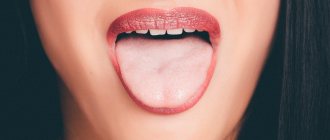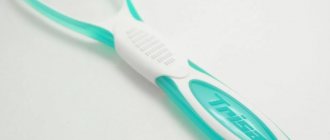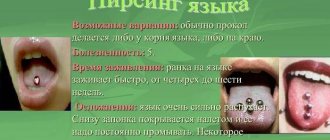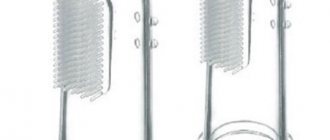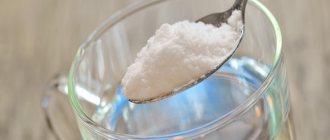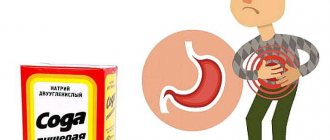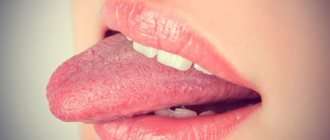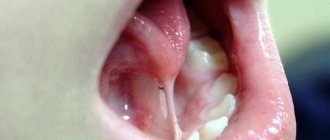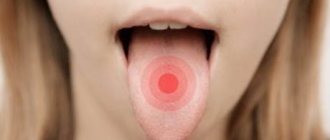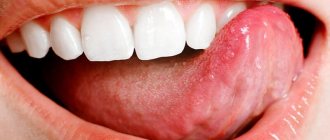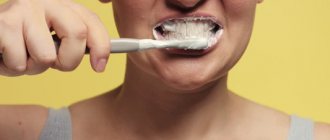Many parents believe that oral hygiene begins with caring for the first, baby teeth. In fact, even earlier - by cleaning the tongue and gums. Moreover, according to the New York State Department of Health, you need to take care of your baby's oral cavity from birth.
Why do you need to clean your baby’s tongue?
A clean environment in the mouth promotes the health of the first, baby teeth.
Here are a few more reasons why you should brush your baby’s tongue:
- Breast milk, like formula, contains sugar. This is why it is important to clean your baby's tongue and gums after feeding.
- Oral thrush, or oral thrush, is a fungal infection that appears as white patches on the tongue, cheek, roof of the mouth, and gums. Regular cleaning of your mouth helps maintain proper hygiene and helps you avoid such health problems.
- Maintaining oral hygiene from an early age accustoms the child to a certain routine and order, and in the future there will be no problems with a toothbrush or tongue scraper.
How to clean a baby's tongue?
The baby may initially suck or bite their fingers, thinking they are food. Give your baby time to adapt to new sensations.
- Wash your hands thoroughly with soap and water.
- Dip a clean sponge or gauze pad into warm water and wrap it around your index finger.
- Gently open your baby's mouth and insert your finger inside.
- Move your finger in a circle on top of your tongue, being careful not to slide down to your throat.
- If the baby has already developed baby teeth, they should also be cleaned with gauze, as well as the gums and the inside of the cheek.
- When brushing your tongue, be sure to check your mouth for any stubborn, thick white coating. This could be oral candidiasis.
It is recommended to clean your child's tongue and mouth at least once a day.
How to clean a baby's gums?
- Distract your child during the procedure.
- Hold your baby in your arms to coordinate his actions.
- Wait until your child is in a good mood before starting the procedure.
- Set aside a specific time during the day for the procedure. This helps create a sense of routine.
The following precautions will help avoid any injury during the procedure:
- Only use a clean sponge to avoid the risk of any infection.
- Keep nails short and clean to avoid any injury to baby's delicate tissues.
- Do not forcefully clean your child's tongue.
References:
- Infant and Children's Oral Health; The New York State Department of Health
- Breastfeeding: 6 Things Nursing Moms Should Know About Dental Health; American Dental Association
- Thrush—Child; Winchester Hospital
On the Vikids platform you can:
How to properly clean your tongue
Dental experts recommend using tongue hygiene tools after brushing and antibacterial rinsing.
In the direction from root to tip, using “combing” movements, you should first clean one part of the tongue, and then the other. Then clean your tongue with crosswise movements to remove plaque from the depressions. Afterwards you need to rinse your mouth with water. For rinsing, you can use antiseptic rinses. But you shouldn't abuse them. It is better to consult a dentist. A specialist will help you choose the most suitable hygiene tool and determine the frequency of use of the rinse aid.
Is a regular brush suitable for cleaning?
Experts do not deny the effectiveness of using a traditional toothbrush as a tongue cleaning tool. You should choose a tool with soft bristles, apply a little toothpaste to it and gently clean the surface. You can choose devices with a textured surface made of plastic or rubber.
After cleaning your teeth, you need to turn the brush over and clean the organ using the movements described above. An electric and ultrasonic brush and irrigator are also suitable for cleaning the surface of the tongue.
When did people start cleaning their tongues?
Even in ancient times, people realized that it was necessary to clean their tongue. The Uzbek doctor Avicenna was one of the first to recommend cleaning the tongue in his treatise “The Canon of Medical Sciences”. He suggested using cypress cones as a device. The texture of the cone has a rough surface of medium hardness, therefore it is optimal for cleansing. Also, the cypress cone has bactericidal properties; its resin has a disinfecting effect on the oral cavity.
Representatives of Ancient China chose silver scrapers as a hygiene device. This technique was also used in the territory of Ancient Rus'. People from the upper classes believed that cleansing the organ allows not only to care for it, but also to enhance the sense of taste. The instruments were used before meals to stimulate the taste buds.
So what should you choose?
Cypress cones and silver scrapers have been replaced by irrigators, ultrasonic brushes and other modern means. To choose the most suitable one for yourself, consult with a specialist - he will take into account the condition of your oral cavity and help you make the right choice.
Other means
When cleaning your tongue at home, other means can be used. One of the most popular ways is to use vegetable oil. A tablespoon of oil is carefully rubbed throughout the entire oral cavity. After cleansing, the oil should turn white. It must be spat out and your mouth rinsed with warm water.
The duration of the procedure is at least 15-20 minutes. It is more effective if done in the morning before eating.
Another way is to use baking soda. Dilute 2-3 teaspoons in a glass of warm water and rinse your mouth with the resulting solution. A small amount of baking soda can be applied directly to the brush to clean the tongue.
You can buy tongue cleaning gel at the pharmacy. It eliminates pathogenic bacteria, produces a softening effect, moisturizes the soft tissues of the oral cavity and provides fresh breath.
A small amount of gel is applied to the surface of the organ to be cleaned, carefully distributed, left for a few seconds and removed with a brush. The procedure can be recommended for both adults and children. Children under 12 years of age should only brush their tongue with the gel under adult supervision.
If there are injuries and various injuries, blood may bleed while cleaning the tongue. To stop bleeding, you need to press a sterile napkin to the wound surface and hold it for about 10 minutes. Hands should be washed well and disinfected with alcohol. Then rinse your mouth with cold water. Do not cauterize wounds with alcohol or treat them with iodine.
Cleaning the tongue. Other methods
We usually hear or read the phrase “imbalance of microflora” or “dysbacteriosis” in relation to the condition of the intestines. In fact, both beneficial and harmful microorganisms also exist in the oral cavity.
And, of course, their correct ratio is very important: if the number of harmful microorganisms for some reason predominates, this leads to increased plaque formation, including on the tongue
If the balance of oral microflora is disturbed, you should be more careful about hygiene. There are also methods aimed at suppressing harmful microorganisms in the mouth, which are good to perform in parallel with brushing the tongue in the mornings and evenings.
Carrying out diagnostics
Some young parents believe that they can diagnose the disease themselves.
However, only an experienced doctor can establish the exact cause of the symptom and make a diagnosis.
During the examination, the pediatrician will assess the baby’s general condition, check the lymph nodes and, if necessary, refer to specialists :
- dentist;
- infectious disease specialist;
- neurologist;
- gastroenterologist;
- endocrinologist;
- nephrologist;
- immunologist.
For your information! To determine the cause that caused the appearance of an unpleasant symptom in a newborn, the small patient is prescribed a series of examinations and tests.
Possible diagnostic methods include:
- biochemical blood test - performed to assess the condition of the gallbladder, liver and pancreas;
- general blood test – necessary for diagnosing infectious and inflammatory processes in the body;
- bacteriological culture for microflora from the oral mucosa - prescribed for suspected candidiasis or viral stomatitis to identify the pathogen;
- Abdominal ultrasound, gastroscopy or fluoroscopy – performed if gastritis is suspected;
- coprogram – carried out to diagnose intestinal microflora.
Oral hygiene
It is necessary to brush your teeth at least twice a day - children absorb this almost with their mother’s milk.
It is important to form this habit at as early an age as possible. Ideally, it is necessary to start immediately after the appearance of the first teeth, so that the baby gradually gets used to the procedure
Every mother chooses an age-appropriate brush and toothpaste for her child, but not everyone is interested in how correctly they carry out hygiene measures.
Firstly, you should not brush your teeth by moving the bristles along the jaw, as this will thin out the enamel faster.
Secondly, it is necessary to pay careful attention not only to the front, but also to the back, as well as the chewing surface, on which plaque may also accumulate or food particles may remain, because the goal is to maintain health, not beauty, and the second is impossible without the first
Another common mistake is completely ignoring the rest of the mouth. Cleaning the tongue and the inner surface of the cheeks, as well as massage of the gums, as a rule, are not carried out at all or occur only from time to time
This is wrong; you need to constantly pay attention to these parts, because the health of your teeth also depends on their environment. And careful attention to the rest of the mouth can prevent a large number of extremely unpleasant diseases, so do not neglect it
When should you consult a doctor?
You should know! You need to show your child to a pediatrician and undergo an examination if:
- the baby is suffering from diseases of viral etiology - the symptom may be a sign of infectious stomatitis;
- the white coating has a cheesy consistency and is difficult to remove by regular wiping - this indicates the appearance of thrush;
- plaque forms not only on the tongue, but also on the gums, inner lips, tonsils;
- the child has become restless and irritable, refuses to feed and cries constantly.
If the plaque disappears a few hours after its appearance, and the baby’s general condition is normal, there is no need to see a doctor.
Reference! This is explained by the fact that in this case the symptom does not warn of the development of pathology and is not considered dangerous.
How to clean plaque from your tongue and restore it to a healthy appearance?
Ideally, a small white coating is always present on the tongue of a healthy person. This is normal and should not cause concern. But what to do if the layer of this plaque becomes significant, it changes its color to yellow, black and even green, and your breath begins to smell bad? The cause of this phenomenon should be sought as soon as possible and measures taken to remove such deposits.
White plaque may indicate some kind of infection and digestive problems.
It can turn yellow due to a malfunction of the liver and gall bladder, but black and green plaque color is rare and in the first case signals an increase in blood acidity, Crohn's disease, cholera and others, and in the second we can talk about yeast, mycotic or candidal glossitis.
Changes in the structure, color and volume of plaque at different times can be observed by heavy smokers and alcohol abusers. In any case, yellow plaque, like any other, requires combating this problem, and it should be started only after the cause has been determined.
How can you clean your tongue from plaque? First of all, it is necessary to maintain oral hygiene by regularly brushing your teeth twice a day. Today on sale there are special brushes with a ribbed base that allow you to clean your tongue.
If you cannot find such a brush, you can use a regular spoon, cleaning the surface with its edge. Experts advise resorting to the help of traditional medicine. A decoction of sage, chamomile and oak bark has a good effect. It is used to rinse the mouth after every meal.
Beekeeping products, known for their medicinal properties, can also come to the rescue. So, an alcohol solution of propolis can be used for rinsing, and if there is a pure product, it is recommended to chew its pieces for several minutes 3-4 times a day. How else can you clean your tongue from plaque? Regular gauze or cotton cloth.
Just wrap your index finger in a piece and walk over the surface of the plaque-covered organ. In ancient India, it was customary to solve this problem with the help of oil. You can use this method too.
It is enough to hold a spoonful of oil in your mouth for 7-10 minutes, shaking occasionally, to get rid of harmful waste in the oral cavity.
How can you clean a newborn’s tongue of plaque? In babies, a white coating on the tongue is a common occurrence, because in the first year of life, the basis of their diet is mother's milk or formula. But it often happens that the child’s gums, palate and cheeks become covered with plaque.
In this case, the doctor prescribes special treatment and recommends cleaning, but how to do this? There is no need to be scared, there is nothing complicated about it and, having calmed down enough, you can completely cope with the doctor’s task on your own.
Here are some ways to clean your baby's mouth:
- Prepare a swab from a bandage and, moistening it in a solution of baking soda, treat the oral cavity. A solution of soda can be replaced with borax in glycerin;
- How can you clean your child’s tongue from plaque? Buy pink vitamin B12. Moisten the bandage with the solution and let the baby suck. You can simply inject a portion of the vitamin into your mouth with a syringe without a needle;
- You can blot the surface of the tongue and oral mucosa with the same bandage swab dipped in an aqueous solution of myrrh and ratania. You need to buy these two tinctures at the pharmacy, mix them in equal parts and dilute them with water in a ratio of 1:2;
- The uvula and mucous membrane can be wiped for a newborn baby with a swab dipped in an oil solution of “Chlorophyllipt”. If your baby has thrush, it is recommended to treat the oral cavity with a mixture of vitamin B12 and one crushed Nystatin tablet.
In the future, it is necessary to more carefully monitor hygiene and prevent dirt and bacteria from getting into the baby’s mouth from a pacifier that has fallen on the floor, unsterilized bottles, unwashed toys, etc. For adults, it is also better to prevent the occurrence of this unpleasant problem than to treat it.
Therefore, if you brush your teeth, floss regularly and rinse your mouth with special solutions, then harmful waste in the oral cavity is unlikely to occur. Be healthy!
Treatment
Need to know! A white coating on the tongue of a newborn is not an independent disease.
Therefore, therapy consists of careful oral hygiene and treatment of the underlying pathology .
Medicines and their dosage regimen are prescribed by the attending physician after consultation and diagnostics .
In the treatment of infants the following are used :
- Enterosgel . Destroys pathogenic bacteria in the gastrointestinal tract, fights dysbiosis and various pathologies in the gastrointestinal tract. The drug does not contain dangerous or harmful components, therefore it is absolutely safe for newborns.
- Espumisan. A remedy that has a carminative effect. Espumisan helps eliminate intestinal colic, bloating, normalize intestinal microflora and improve the functioning of the gastrointestinal tract.
- Viferon. An immunomodulatory drug with antiviral action in the form of an ointment for external and local use. The medication is indicated for damage to the oral mucosa due to infections or viruses.
- Candide. An effective antifungal agent for the treatment of thrush in young children. The drug quickly eliminates white plaque and other symptomatic manifestations caused by a fungal infection, and also improves the child’s well-being.
Important! Alternative medicine recipes are not used to treat various diseases and eliminate white plaque on the tongue of an infant.
Since herbal decoctions and infusions can worsen the general condition of the child and lead to a severe allergic reaction.
Which hygiene product is better?
The list of devices for oral care is huge. In the first place are special scrapers for cleaning the tongue. They are made of plastic and resemble a tool with a long handle and a spoon tip. It is recommended to change products at the same frequency as a toothbrush.
Scraper brush
The device is characterized by a combination of scraper and brush and has very delicate bristles. The shape is flat, which helps prevent the occurrence of a gag reflex during the process of cleansing the tongue.
You can often purchase products with convex rubberized or plastic embossed strips, which promote better hygiene.
Spoon
A tongue cleaner is another great tool. Presented in the form of an elastic nozzle ending with a spoon. The water that flows through the instrument allows for manipulations to be performed quite efficiently and gently. Very often, such spoons are used as attachments for electric brushes, as well as irrigators.
Toothbrush
Many people often use regular toothbrushes with toothpaste. In such a situation, it is better to choose products with soft or medium-hard bristles. In addition, you can purchase a special brush with a textured surface on the back side. Upon completion of hygienic procedures with teeth, the device is turned over and movements are made in the direction from the root of the tongue to its tip.
You can clean the surface with your usual toothbrushes, as well as with ultrasonic, electric or irrigators. Owners of the latest devices only need to purchase a tongue attachment.
Types of scrapers
Manufacturers offer several types of devices for removing deposits:
- scrapers;
- brushes;
- spoon-shaped irrigator attachments;
- scrapers-brushes.
All models differ in external shape, quality and characteristics of the material, and purpose.
Why can't you use a regular toothbrush for this procedure? You can clean the mucous membrane with a simple teaspoon and a toothbrush. But this should be a temporary measure, since with constant use of these items you can accidentally injure the delicate surface of the mucous membrane.
Brushes
How to choose the right brush for removing plaque? You should pay attention to the material of the product, the shape and stiffness of the bristles. Dentists do not recommend using brushes with hard bristles, as they injure the mucous membrane and contribute to the development of inflammation.
It is advisable to choose a brush with soft bristles that delicately remove plaque and deposits.
Basically, brushes are made of special plastic, but there are products made of silver or with the addition of silver. Salivary fluid activates the antibacterial properties of this metal.
The shape of the brush also matters for ease of use. It is advisable to choose a product with a long handle, which will allow you to clean the root of your tongue without strain. The shape of the brush and handle should be as adapted as possible to the shape of the tongue.
What hygiene product should I use to remove plaque using a brush? It is better to use special antibacterial agents in the form of gels to achieve maximum effect. Special ingredients included in the gel formula will keep your breath fresh and your mouth feeling pleasant for longer.
Scrapers
These devices resemble a spatula in shape and are preferred by people with a strong gag reflex. The product is designed so that its touch does not irritate the surface of the tongue and does not provoke gagging. When choosing a scraper you should consider:
- product material;
- the shape of the handle and blade;
- ergonomics.
The material matters, as manufacturers make products from copper, plastic or silver. Silver models will additionally disinfect the oral cavity, destroying pathogenic microflora. Copper models will last a long time, compared to plastic ones, which must be replaced every two weeks. But metal scrapers require cleaning with boiling water, do not forget about this.
The scraper blades should be easily washed under the pressure of a stream of water.
This is very important as they should be rinsed after each cleaning stroke. The shape of the blade and handle should be ergonomic
The handle should not slip in the hand, and the blades of the paddle should conform to the shape of the tongue.
A tongue scraper with two blades removes deposits much faster than models with one. Manufacturers claim that the machine with two blades prevents the induction of vomit. This type not only copes with its task more effectively, but also reduces the time of hygienic manipulations.
It is also worth paying attention to innovations: manufacturers offer a combined product that combines the functions of a brush and a scraper. This model, with its rounded shape, resembles a spoon, but has bristles on it
With the help of such a device you can remove the densest sediment.
Irrigator attachments
An irrigator is a device for cleaning teeth with a stream of water under pressure. This is a soft and gentle, but very effective oral care product. A stream of water penetrates into the most inaccessible corners of the oral cavity, freeing them from the accumulation of food particles and bacterial deposits.
To remove plaque using an irrigator, a special spoon has been created that helps care for the surface of the tongue. The spoon does not cause gagging and efficiently removes deposits from all sides. Use the spoon attachment immediately after brushing your teeth. You should first carefully read the instructions, as some models are equipped with additional functions.
How and when to start cleaning your child's tongue
How to clean a baby’s tongue, and whether this is necessary, is a question that concerns many conscious parents. Of course, there are no indications for this procedure for a newborn, but with the appearance of the first tooth, it’s time to start.
Today the most popular brands are ROCS, Chicco and Splat. The surface of the brushes is made of silicone bristles or has a ribbed appearance. There is not much difference between them, the products work equally effectively, it all depends on the preferences of the parents and the baby.
To properly clean a newborn’s tongue, a finger toothbrush is placed on the finger. The movements should be smooth, as if “sweeping”, moving in the direction from the root of the tongue to the tip.
After performing several movements according to this principle, you can begin to cleanse the lateral surfaces of the organ. Then move to the inside of your cheeks, and after that be sure to rinse your mouth.
Until your child is able to rinse his mouth on his own, it is not recommended to use any toothpaste!
As a rule, it takes no more than three minutes to clean your tongue. Irregular and poor oral hygiene provokes the development of pathogenic flora, which, in turn, can lead, for example, to caries, glossitis or stomatitis. It turns out that in a matter of minutes you can remove bad breath and prevent the development of many diseases.
Everyone knows that preventative measures are always more pleasant and less expensive than treatment. Therefore, it is better to acquire a new useful habit - brushing your tongue every time after teeth.
How to remove plaque from the tongue at home
How and with what to clean the tongue of an adult? There are several ways to quickly deal with this problem. Let's look at each of them in more detail.
Scrapers
These are special loop-shaped devices made of hygienic plastic. Scrapers effectively remove plaque without causing discomfort or gag reflexes. The tool must be moved from the base of the tongue to the tip until the film disappears. After this, the mouth can be rinsed with an antibacterial solution.
Toothbrushes
Most models have special pads on the back surface or removable attachments for removing plaque. Hygienic procedures are carried out according to the scheme discussed above. To enhance the effect, you can apply a small amount of toothpaste to the surface of the nozzle.
Irrigators
These are modern devices for comprehensive oral care. The essence of the irrigator’s work is the directed supply of a stream of water, which gently but effectively removes food debris and plaque on tooth enamel and tongue. Irrigators work very delicately, the possibility of damage to the mucous membrane is completely eliminated. In this case, to enhance the effect, water can be replaced with a medicinal liquid with an antibacterial or anti-inflammatory effect.
Spoons
Sold in pharmacies, in appearance they resemble a small spatula with rounded edges. Thanks to this form, the possibility of injuring the tongue is eliminated.
Special spoon attachments are available for irrigators. For example, a replaceable nozzle TS-100E. This instrument is recommended by dentists for daily hygiene procedures; it effectively removes plaque and helps freshen breath.
Rinse
To clean the tongue, decoctions based on medicinal herbs and plants are used:
- Oak bark;
- Propolis;
- Calendula;
- Sage.
However, it is important to understand that it will not be possible to remove plaque with the help of decoctions alone. This method cannot replace mechanical cleaning and is used rather for preventive purposes.
Is it necessary to clean your tongue of plaque and why do it?
The tongue should be cleaned of plaque every day during morning hygiene procedures. Regular and high-quality cleaning of the taste organ:
- reduces the concentration of pathogenic bacteria in the oral cavity;
- is an excellent prevention of infectious diseases;
- prevents the development of digestive problems;
- helps protect tooth enamel and prevents caries;
- eliminates unpleasant odor from the mouth;
- improves taste perception.
Tongue of a healthy person
The tongue of a healthy person is pink. It should be elastic, moist, without wounds, cracks and swelling. Even with ideal health, a thin layer of white or gray plaque periodically forms in the mouth, which can be easily removed by carrying out simple hygiene procedures.
But the plaque can be different: one can be removed on your own, while the other can only be removed after long-term treatment under medical supervision. Plaque on the tongue is a kind of indicator of a person’s health status, therefore, if there are any changes in its color or structure, you should consult a doctor to identify and treat the disease that triggered the development of such signs.
Prevention
In order to prevent the appearance of plaque on a child’s tongue, there are a number of preventive measures that many experts emphasize (for example, Ukrainian pediatrician Komarovsky):
- The room in which the child lives should always be clean, well ventilated and humidified.
- You should not prescribe antibiotics to your child yourself. The use of such medications must be strictly justified.
- It is necessary to closely monitor the baby's health. If the slightest symptoms appear that indicate a possible disease from the internal organs, you should urgently seek medical help.
- Limit your child's consumption of sweets containing synthetic coloring pigments: sweet carbonated drinks, candies, chewing gum. This will not only prevent the appearance of active staining of the tongue, but will also preserve the health of delicate children's teeth.
If plaque does appear on the tongue, there is no need to try to remove or treat it yourself. Consult your doctor about the possible causes of this phenomenon and the necessary treatment for it.
Rinse your mouth with hydrogen peroxide solution
After breakfast, I recommend rinsing your mouth with a solution of water and hydrogen peroxide. You need to buy a peroxide solution at the pharmacy, it costs a penny, but it has a lot of benefits!
Rinse solution: 10 drops of 3% peroxide solution per 50 mg of clean, unboiled water. There is no need to increase the proportion of peroxide; you can “burn” the mucous membrane.
What does this give?
1. Prevention of dental and gum diseases. Those who regularly rinse with peroxide go to the dentist mainly only for preventive examinations.
2. After regular antiseptic treatment of the oral cavity, “bad” odor from the mouth is eliminated.
3. Teeth gradually whiten.
These are the simple morning procedures, tested from our own experience. In general, my set of morning procedures is much longer and lasts more than an hour. In addition to the simple recipes listed in the post, there are also acupressure massage, contrast showers, joint gymnastics, the Vietnamese Ziongshin yoga complex, the Baitap Khi breathing complex, special exercises for the spine, the Wing Chun martial practice complex, and meditation. After all this, you get an excellent charge for the whole day. Gradually, in other articles I will tell you about the other listed practices.
Thank you for your attention!
Sergey Borodin, 2013
This and other topics are covered in more detail in my books in the “Phoenix Code” series. Technologies for changing life." LOOK.
Benefits of Cleaning Your Tongue Regularly
Hygiene of the surface of the tongue is not a tribute to fashion and not just another invention of manufacturers of oral care products
Special attention has been paid to this for a long time. The tongue scraper was made from turtle shell or ivory
Later they began to be cast from silver. The medieval physician Avicenna wrote about the benefits of hygienic tongue care in his treatises. In the time of Avicenna, split sticks of wood rich in essential oils or small cypress cones were used for hygiene.
In India, the benefits of mucosal hygiene were also correctly assessed. Yogis used wooden spoons or cleaned the mucous membranes with three fingers wrapped in cotton.
Regular tongue care helps:
- strengthening the immune system;
- normalization of taste perception of food;
- prevention of bad breath.
How does oral hygiene improve the immune response? Toxic substances—bacterial waste—accumulate in the white coating. Unremoved toxic substances are absorbed into the blood over time, forcing the immune system to fight their harmful effects. Accordingly, removing toxins does not burden the immune system, which helps strengthen it.
Taste buds are located throughout the surface of the tongue, it is thanks to them that a person feels and recognizes taste. Bacterial sediment on the surface clogs the taste buds, reducing the pleasure of eating food. Freeing the taste buds will restore the correct perception of foods.
Most bacteria are found on the root of the tongue. Thanks to the convenient shape of the sediment scraper, you can get rid of many pathological microorganisms and achieve fresh breath. In addition to eliminating deposits, the cleansing brush has a gentle massaging effect, promoting high-quality blood circulation in the oral cavity.
The tongue can be used to diagnose diseases, so its cleanliness will indicate a healthy body. Regular cleansing will bring not only aesthetic benefits, but will also promote health and allow you to recognize the onset of diseases of the internal organs. If a lot of deposits have accumulated on the mucous membrane, this indicates a serious internal disease.
Types of plaque and disease
- A thin white coating indicates a decrease in the body’s protective functions;
- a coating of cheesy consistency signals the development of a fungal infection in the oral cavity;
- mucous membrane in cracks warns of the development of gastritis;
- a gray tint of deposits indicates a severe complication of the existing disease;
- a yellow tint of deposits indicates problems with the gastrointestinal tract and liver;
- a green tint indicates problems with the liver, which is not able to cope with its functions;
- a brown tint occurs in alcohol-dependent people or in cases of problems in the gastrointestinal tract;
- a black tint occurs in heavy smokers or in people with serious disorders of the liver and gastrointestinal tract.
The advantage of regular use of a scraper is precisely the timely diagnosis of the onset of diseases.
Associated symptoms
Stay up to date! Depending on the cause of the appearance of a white coating on the tongue, the newborn may also be bothered by additional symptomatic manifestations.
By monitoring the child’s condition, parents can identify the following symptoms :
- increased body temperature;
- swollen lymph nodes;
- pale skin;
- abdominal pain;
- constipation or diarrhea for more than three days;
- green mucus in stool, foam, or blood;
- intestinal colic;
- rumbling in the stomach;
- frequent excessive regurgitation or vomiting;
- bad breath;
- redness on the oral mucosa;
- manifestations of allergic dermatitis in the form of a rash;
- formation of blisters, wounds and ulcers in the mouth;
- loss of appetite;
- dry mouth or excessive salivation;
- bright red color of the tongue in areas without plaque;
- swelling of the gums and tongue;
- jams and cracks in the corners of the lips;
- lethargy;
- poor weight gain;
- breast refusal;
- irritability.
Why does plaque appear on the tongue and its signs?
There is plaque even on the tongue of a completely healthy person. It appears because particles of consumed food are retained between the taste villi and lingual papillae, causing the active proliferation of bacteria. Over time, bacteria die due to the work of the immune system, but they do not disappear without a trace - food particles, saliva, keratinized epithelial cells, dead microorganisms and their metabolic products settle on the tongue and form plaque.
During eating and thanks to salivation, plaque almost completely disappears from the surface of the tongue. However, most often the basal region and the root of the tongue remain covered with a thin film, through which the lingual papillae can be easily seen. This residue is also littered with germs that can trigger the development of numerous dental diseases - which is why you need to regularly remove it when brushing your teeth.
Signs of plaque on the tongue are within normal limits
Even in the absence of supporting symptoms, coating on the tongue may indicate health problems. But you shouldn’t run to the doctor immediately after discovering this unaesthetic film. Sometimes it is normal, in this case you just need to regularly clean your tongue and remove the plaque that forms on it. But if there are pathological signs, it is necessary to visit a doctor as soon as possible and undergo a diagnosis.
Plaque occurred due to natural physiological reasons if it:
- whitish or yellowish;
- homogeneous;
- does not cause pain;
- covers the root and basal region of the tongue with a thin layer, and the lingual papillae are visible through it;
- easy to remove with regular hygiene;
- appears after eating food, in the morning, due to thirst;
- has no unpleasant odor;
- not accompanied by other symptoms.
Signs of pathological plaque on the tongue
A coating covering the tongue may indicate that the body is experiencing certain problems. In such cases it becomes:
- thicker and denser;
- not amenable to removal;
- yellow, gray, brown, green, red or even black;
- covering the entire tongue or its lateral parts;
- smelling bad;
- accompanied by a bitter taste in the mouth.
What diseases may a coating on the tongue indicate?
It is impossible to determine the cause of plaque formation at home; for a reliable diagnosis and prescribing the correct course of treatment, you should consult a doctor. But you can guess what diseases could lead to the manifestation of such symptoms on your own.
Candidal glossitis (thrush)
Yellow, yellowish-gray and white plaque may indicate the following pathologies:
- disruptions in the digestive system, inflammatory processes, dysbacteriosis;
- gastritis, stomach ulcer;
- impaired intestinal motility, flatulence, problems with bowel movements;
- liver damage;
- inflammation of the oral mucosa (glossitis);
- diseases of the gums, teeth, palate;
- disturbances in the functioning of the endocrine or hormonal system;
- poisoning, malnutrition, mild dehydration;
- the presence of worms;
- malignant and benign formations.
A greenish coating may indicate fungal diseases and long-term drug therapy. Brown is a constant companion of people who abuse smoking, drinking alcohol and eating heavy food. In addition, it may indicate diseases of the upper and lower respiratory tract.
Villous glossitis
Black plaque is rare and usually accompanies serious diseases such as:
- Crohn's disease;
- severe dehydration of the body;
- increase in blood acidity;
- villous glossitis;
- pancreatitis or cholecystitis.
It should be taken into account that consuming products containing strong dyes also affects the color change of plaque in the mouth. If it turns yellow or blue-green immediately after eating a candy of a similar color, then there is no need to look for another reason for this phenomenon.
Features of consistency and thickness of plaque
By paying attention to the thickness and consistency of the plaque covering the tongue, you can identify the reason why it appeared:
- a thin layer of wet plaque - occurs after feeding or regurgitation;
- a thin layer of dry deposits – an allergic reaction;
- thick whitish coating – indicates dysbacteriosis;
- viscous dense formations of white color - gastritis with high acidity;
- dense cheesy – viral stomatitis;
- thick, loose plaque – thrush or candidiasis.
Which hygiene product is better?
The list of devices for oral care is huge. In the first place are special scrapers for cleaning the tongue. They are made of plastic and resemble a tool with a long handle and a spoon tip. It is recommended to change products at the same frequency as a toothbrush.
Scraper brush
The device is characterized by a combination of scraper and brush and has very delicate bristles. The shape is flat, which helps prevent the occurrence of a gag reflex during the process of cleansing the tongue.
You can often purchase products with convex rubberized or plastic embossed strips, which promote better hygiene.
Spoon
A tongue cleaner is another great tool. Presented in the form of an elastic nozzle ending with a spoon. The water that flows through the instrument allows for manipulations to be performed quite efficiently and gently. Very often, such spoons are used as attachments for electric brushes, as well as irrigators.
In addition, you can learn from people’s experience of how to clean your tongue from plaque with a silver spoon. It’s interesting that, for example, yogis use a wooden spoon for this.
But here it is important that the device is used only for these purposes
Toothbrush
Many people often use regular toothbrushes with toothpaste. In such a situation, it is better to choose products with soft or medium-hard bristles. In addition, you can purchase a special brush with a textured surface on the back side. Upon completion of hygienic procedures with teeth, the device is turned over and movements are made in the direction from the root of the tongue to its tip.
You can clean the surface with your usual toothbrushes, as well as with ultrasonic, electric or irrigators. Owners of the latest devices only need to purchase a tongue attachment.
Plaque on the tongue. What to do
If you notice a thick layer of plaque on your tongue or a change in its color, then do not immediately panic.
Firstly, we need to analyze what we ate before, since the color of the tongue is often influenced by dyes in the composition of some food products, for example, in candies, caramels (especially lollipops and all kinds of candies - sweets from advertising) or the products themselves , this could include blueberries or coffee. After cleaning your mouth, this plaque should disappear.
Secondly, it is necessary to analyze the reasons causing increased plaque formation on the tongue.
Thirdly, you need to note how many hours after the morning cleaning of the oral cavity plaque appeared. If more than 3 hours later, then this is normal. It is also considered normal if the coating on the tongue normalizes after 5-7 days.
If plaque still bothers you, then first of all you need to be more careful about oral hygiene and carry out hygiene procedures twice a day.
The next step is a balanced diet, since a thick layer of plaque on the tongue can form after eating certain types of food, for example, after fatty, smoked, fried foods. Change your diet, giving preference to cooked foods, as well as fresh vegetables and fruits.
For these purposes, you can also use pharmaceutical preparations. Often a thick layer of plaque on the tongue occurs due to stagnation of bile in the gallbladder. Allohol tablets are a choleretic agent of natural origin. You can consult a doctor; usually the doctor prescribes a course of treatment from 2 to 4 weeks, two tablets three times a day before meals.
An important point for getting rid of plaque on the tongue is to normalize stool and get rid of constipation.
If these steps do not help and plaque still appears, you should definitely consult a doctor and undergo a full examination. When the disease leading to the formation of plaque is eliminated, the plaque will disappear on its own.
Reasons for appearance
A white coating on a baby's tongue often appears as a result of breastfeeding.
However, the occurrence of this symptom can also be caused by various diseases and non-pathological factors . Among them:
- Candidiasis or thrush . It occurs when the bactericidal properties of saliva are lost and is diagnosed when active activity of yeast-like fungi is detected. The pathological process develops as a result of insufficient oral hygiene and without proper treatment can lead to damage to the larynx and internal organs.
- Disruption of the gastrointestinal tract . In the first months of life, the child’s gastrointestinal tract is not sufficiently formed. Because of this, the intestinal microflora can be disrupted due to poor nutrition. Babies who are bottle-fed or mixed-fed are especially susceptible to the problem.
- Gastritis with high acidity. The disease is extremely rarely diagnosed in infants and becomes one of the reasons for the appearance of white plaque. Acidity disorders in early childhood are associated with parasitic lesions of the gastrointestinal tract or congenital amino acid deficiency. This negatively affects the child's well-being.
- Viral stomatitis. Inflammatory infectious disease of the soft tissues of the oral cavity. It is characterized by a deterioration in the child’s general well-being, the appearance of mouth ulcers and an increase in body temperature. The occurrence of stomatitis is caused by acute and chronic diseases that can weaken the baby’s immunity.
- Allergic reaction. Appears as a result of long-term use of certain medications, consumption of infant formula, or contact with an allergen.
- Decreased hemoglobin levels in the blood. The problem is related to iron deficiency and often leads to oxygen starvation because cells and tissues do not receive enough oxygen. In this case, the blood circulation process is disrupted, and the microelements necessary for the body are poorly absorbed.
Keep in mind! Plaque that appears on a baby after feeding or regurgitation is not a sign of the development of a serious disease.
